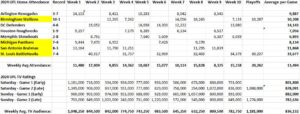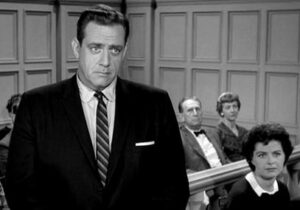Podcast: Play in new window | Download
Subscribe: RSS
This Sunday afternoon, the final game of the 2024 United Football League (UFL) season will be played. The UFL (in case you forgot) was the result of a merger between 2023’s two money-losing spring football leagues called the USFL and XFL. With 16 football franchises between those two leagues operating in 2023, half were eliminated in 2024 in order to cut costs.

On Sunday afternoon at 4PM CDT on Fox, the two-time USFL defending champion Birmingham Stallions will face-off against the San Antonio Brahmas. The spring pro football championship game will be played – in St. Louis?
St. Louis has been, by far, the lone shining star in this eight-team football league during 2024.

The Battlehawks were able to draw more than 30,000 fans to each of their five regular season home games and last week’s semifinal. The UFL management placed a bet earlier this season that the good people of St. Louis will show up in larger numbers than if the title game was played in the home city of the top seeded finalist.
Unlike the NFL’s Super Bowl, tickets are plentiful for Sunday afternoon’s UFL championship game in St. Louis. A quick check today showed that loge and upper deck tickets were available for as low as $9 (correct). A 50-yard line seat for Sunday’s championship game can be purchased for about $85.
Attendance for the other seven UFL cities was dreadful
Having won the USFL title in both of the past two seasons, I really expected better fan support in Birmingham with the newly consolidated UFL this spring. That didn’t happen.

Birmingham (led by former Louisiana Tech head coach Skip Holtz) finished with a sterling 9-1 record for the regular season but averaged a disappointing 10,208 paying customers this season. The team’s playoff game last Saturday in Alabama had just 10,287 fans. Sure, temperatures in Birmingham last weekend were in the low 90’s with heat indexes reaching the upper 90’s. That’s not exactly “football weather” in the South – unless the University of Alabama was playing an early season home football game, that is.
The other finalist, San Antonio, did not fare much better in their UFL spring football home games, either. The 7-3 Brahmas played their regular season games indoors at the air-conditioned and spacious 65,000 seat Alamo Dome. The team (coached by Wade Phillips) averaged just 11,868 fans in their five regular season home games in 2024.

Last Sunday, San Antonio came into St. Louis for their semifinal game against the Battlehawks. Despite 30,000 screaming fans pulling for their home team, the Brahmas won the game 25-15 to advance into the UFL championship this Sunday. Ironically, San Antonio must return to St. Louis for a second straight week to play for the title.
Let’s examine the 2024 UFL teams’ average attendance and network television ratings
The lack of interest being shown by football fans in seven of the eight UFL markets is the biggest concern for the spring league’s ownership group.

If you remove St. Louis (33,637 per home game) from the 2024 attendance figures, the other seven UFL teams averaged only 9,741 fans per home game.
That is lower than 130 of the 133 FBS major college football teams in 2023. Only Northern Illinois (9,456), Sam Houston (9,406), and Akron (7,508) averaged fewer football fans last fall.
It’s not the facilities or the marketing. The primary problem remains the lack of “name” players and a minor league feel to the game.
Ready to crunch some numbers?

As chronicled here in previous articles about spring professional football, the expenses of operating these eight UFL teams (though infinitely lower than the NFL) is not cheap.
With 42 players on the active roster, each UFL team pays $5,500 per week per player. With a ten game regular season schedule, over $2.3 million per team goes to player salaries alone.
For my estimate, let’s also include the coaches and team support staff. That probably brings to the total to at least $3 million per team for employee pay.
Most businesses use a rule-of-thumb that 50% of expenses come from the cost of employees. If that’s the case (and this might be a low-side estimate), each UFL team requires about $6 million annually to cover its expenses.
Let’s now add the cost of stadium leases ($50,000 per home game is my estimate), chartered jets on road games (another $50-100,000 per road game), and assorted other costs (equipment, insurance, security, game day staff, etc.). That is probably another $1 million per year added to each team’s expenses.
Estimated expenses: $7 million per team
On the revenue side, regular season UFL game tickets were quite cheap at about $20-$40 per game. Let’s call it $30 on average. With the seven worst franchises averaging about 10,000 fans per game in attendance, ticket revenues generated about $300,000 per home game.
Let’s generously add another $200,000 in net profits from concessions, merchandise, and, perhaps, parking. That’s $500,000 per home game in revenue. With five home games per season, most teams will see estimated revenue of $2.5 million in 2024.
Estimated revenue: $2.5 million per team

Estimated Net Loss: $4.5 million per team times 8 teams = $36 million
Did we overlook those television revenues?
In the case of spring football in general and the UFL in particular, the answer is more likely, “What TV revenues?”

The cost of providing a network quality football telecast is very expensive. Specialized trucks loaded with television equipment must be driven to each week’s game locations around the country. A staff of about 100 or more professionals must be paid to assemble, test, and then produce a high quality on-air production. Whether for Fox or ABC/ESPN (the two UFL television outlets), the cost of the UFL’s four weekly television games was probably similar to the cost of a major college football broadcast in the fall.
Last season, the XFL and USFL each averaged about 600,000 television viewers per game in the spring of 2023.
The 2024 UFL garnered more than 800,000 viewers per game. Though the UFL and other media may report that as a positive, the total number of spring football viewers just dropped from 1.2 million per week to 800,000 this season.
When compared to the NFL’s average of about 18 million viewers per game in 2023, spring professional football remains a minor blip on the television radar.

To pay for the expensive television production costs every week, the UFL probably agreed to some form of a barter arrangement with each network. In other words, the networks are permitted to sell a certain percentage of the commercial minutes and retain the revenue to offset their production costs. The UFL likely retained a small share of the commercial availabilities per game to sell. It’s possible that the UFL allowed the networks to go ahead and sell their spots as well and then split the revenues. Finally, your local television (or cable) affiliate was permitted to retain a few minutes of commercial time each hour to (potentially) earn local revenue during the games – assuming they are able to sell the spots.
When you see a promo or public service announcement being aired during any televised sporting event, it likely means that a commercial availability went unsold.

In other words, the revenue derived by the UFL from network television advertising was probably minimal in 2024.
The verdict

Despite what you may have heard from the media, the first year of UFL spring football in 2024 may be its last. Here’s why:
- Seven of the eight UFL cities seriously underperformed at the gate. The only reason St. Louis has been such a success is that the city is trying to woo an NFL team to return (good luck with that). The other seven teams cannot all be relocated. The trail of dead bodies of former spring football franchises is quickly growing. New Jersey, Orlando, New Orleans, Pittsburgh, Seattle, Las Vegas, and Tampa Bay have already seen one spring football team come and go over the past three years. There are a few sizable metropolitan areas remaining which might, perhaps, show more promise in the 2025 season (if it is played).
- The UFL’s on-field talent is a noticeable step below NFL quality. The league would have benefited if trades were permitted (prior to the season) to put a higher number of regionally known college football players onto the rosters of any UFL team where local fans would have a connection with them.
- Just three years ago, the USFL’s owners (Fox Sports) stated that the league needed to draw an average of 1.2 million viewers per game to be deemed a success. In 2024, despite playing two games apiece on Saturday and Sunday in an afternoon and evening television window on Fox and ABC/ESPN, the UFL averaged a little more than 800,000 viewers per game. You cannot force people to watch a product which they do not find compelling.
- The financial losses continue to mount. Though never confirmed publicly, the XFL and USFL agreed to merge after the 2023 season in order to stem the tide of massive financial losses. The XFL lost a reported $60 million (or more) in just 2023 alone. The USFL spent more than $100 million just to launch their league two years earlier. As outlined in this post, why should the UFL owners keep doing the same thing and expect to get a different result? How long are the owners willing to lose tens of millions of dollars every year?
- No, the NFL is not coming to the rescue. They understand that “Less is best.” The NFL completely dominates television in the fall. If the NFL became a partner and made the UFL a spring developmental football league, spring football might have a chance to grow. The NFL likes its cozy niche in the fall. Like us, they have closely watched three straight seasons as an improving spring pro football product has failed in the stands and at home via network television. The sports market simply doesn’t want “live” football for an extra three months in the spring. Most fans won’t miss the UFL when it is gone.

In summary, enjoy the UFL’s spring football season finale this Sunday afternoon at 4PM on Fox. It just might be the last spring football game that you will see for a long, long time to come.

